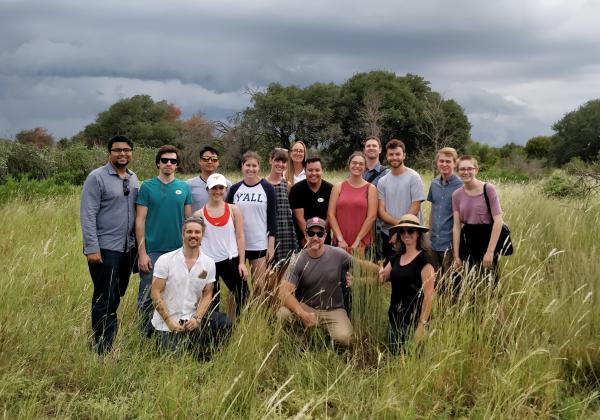Vertical Studio Visits the Wildflower Center

This Fall, Nichole Wiedemann’s Vertical Studio, architecture of CIRCUMSTANCE, is using a project currently under construction in New Braunfels, Texas, which involves a collaboration between LAKE | FLATO, Ten Eyck Landscape Architects, and the Lady Bird Johnson Wildflower Center, as a case study. Given the significant ecological concerns of the design project, the studio is collaborating with the Lady Bird Johnson Wildflower Center, a research unit of the School of Architecture that “brings research, education, and application to the design and planning of healthy landscapes and ecosystems.” In particular, the studio is exploring how the context (site) can condition, influence, and/or determine architectural design.
On September 25th, fourteen graduate architecture students visited the Lady Bird Johnson Wildflower Center for a hands-on workshop on applied ecology. Led by ecologist Michelle Bertelsen and environmental designer John Hart Asher [MLA ’07], the workshop focused on the design implications of ecological theory and practice, including habitat creation with an emphasis on native plants, the sequence of ecosystem maturation, site-specific and regional hydrology, and the importance of soil composition.
Enhancing ecological services—the values and services that people derive from healthy ecosystems—was posited as the goal of incorporating applied ecology into design strategies. Applied ecology is founded upon three premises: 1) Human beings are an inherent part of nature; 2) No part of nature is left untouched by human activity (i.e. the concept of true wilderness is a fantasy); and, 3) The value of a stabilized ecosystem exceeds itself and has a balancing effect on all energy cycles. From these premises emerge a method of ecological restoration that is not necessarily a return to a pristine past, but a design plan that incorporates known strategies to "conserve, restore and create healthy landscapes" (Michelle Bertelsen). Healthy ecosystems, as defined by Bertelsen and Asher, are those that are able to heal themselves and produce a balanced give-and-take of nutrients. The workshop asks students to consider how best to incorporate applied ecology into their projects.
Collaborating with the Wildflower Center and other design professionals (Ten Eyck Landscape Architects and LAKE | FLATO) provides a rare underpinning to an architecture studio with access to site research and background, diverse knowledge sets, client and community perspectives, and professionals in the field.

